2020 Annual Report for: Tineidae / Nemapogoninae
For species seen in 2020 that had less than or equal to 100 records, full details are included; for more common species, the earliest, latest and highest count by vice-county are shown. The narrative for each species is taken from the main Hantsmoths website, and it is possible that some information on abundance and occurrence can get out of date, as it is impossible to keep up with all changes; however it should give a good introduction to each species. The tables in each species account summarise the previous status, and that for the current year.
For the maps, all records prior to 2020 are shown by a blue dot (the larger the dot, the more recent), with the current year's records shown in red. As previous records are superimposed on any report for 2020, new sites have greater emphasis (i.e. will show as 'more red').
In the species accounts, an asterisk next to a location indicates a new 10km square record; earliest ever dates are highlighted in orange, and latest ever in red. Initials in the species accounts refer to the recorders listed here. Please get in touch if you identify any omissions or errors, in particular if you have records that have yet to be submitted. Details of how to submit records can be found here.
12.011 [B&F: 0225] Triaxomera fulvimitrella (Sodoffsky, 1830) - Local
Local in woodland throughout much of mainland Britain, except for the far north, although it is common in the Highlands of Scotland (MBGBI Vol.2 1975). In Hampshire fairly well distributed in both the north and south, but only recorded recently on the Isle of Wight in 2005 at Parkhurst Forest, Wheelers Bay, 2014 and Briddlesford Copse, 2016. Wingspan 15-22 mm. Larva feeds on bracket fungi and occasionally in rotten wood, favouring Birch, Beech and Oak.
Records prior to 2020
| Vice County | #Records | #Individuals | First Record | Last Record |
|---|---|---|---|---|
| 10 | 7 | 7 | 1900 | 2017 |
| 11 | 31 | 28 | 1974 | 2015 |
| 12 | 21 | 40 | 1974 | 2015 |
2020 records
| Vice County | #Records | #Individuals | Max Quantity |
|---|---|---|---|
| 10 | 2 | 2 | 1 |
| 11 | 2 | 2 | 1 |
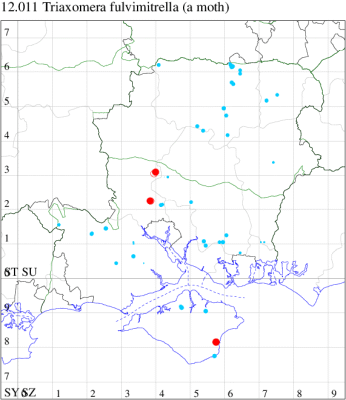
Records by year
Records by week (adult)
Records by week (larval)
Record Details
VC10: Shanklin*, one, 02 Jun; one, gen det, 24 Jun (IOu);
VC11: Romsey*, one, to pheromone lure, to CUL lure, 20 May (NRJ); Kings Somborne*, one, to actinic, 26 May (GCE)
12.012 [B&F: 0224] Triaxomera parasitella (Hübner, 1796) - Local
Local in woodland throughout much of southern England, with records north to southern Scotland. In Hampshire fairly well distributed in both the north and south, but only infrequently on the Isle of Wight with recent records from Parkhurst Forest and Shanklin. Wingspan 16-21 mm. Larva feeds on bracket fungus and dead wood.
Records prior to 2020
| Vice County | #Records | #Individuals | First Record | Last Record |
|---|---|---|---|---|
| 10 | 17 | 13 | 1929 | 2019 |
| 11 | 119 | 113 | 1974 | 2018 |
| 12 | 46 | 39 | 1976 | 2019 |
2020 records
| Vice County | #Records | #Individuals | Max Quantity |
|---|---|---|---|
| 10 | 7 | 11 | 3 |
| 11 | 2 | 2 | 1 |
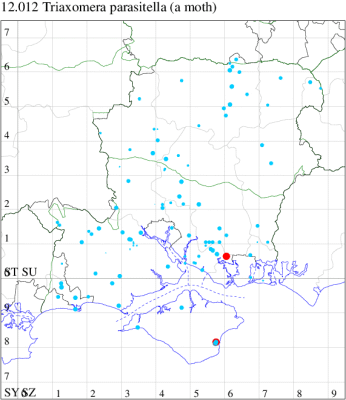
Records by year
Records by week (adult)
Records by week (larval)
Record Details
VC10: Shanklin, two, 14 Jun; one, 15 Jun; three, 16 Jun; one, 17 Jun; one, 21 Jun; two, 01 Jul; one, 05 Jul (IOu);
VC11: Portchester, one, 27 May (JGe); Sway, one, 23 Jun (SKe)
12.016 [B&F: 0216] Cork Moth Nemapogon cloacella (Haworth, 1828) - Common
Common in woodland, but also inside barns and warehouses, throughout the British Isles. Widespread and common in Hampshire, but few recent records on the Isle of Wight. Wingspan 10-18 mm. Flies in late afternoon and in early morning sunshine. The main confusion species is Corn Moth N. granella, which see. Several other similar, but scarce, species may also be encountered: N. ruricolella, N. wolffiella, N. inconditella, N. inconditella and N. variatella. Larva feeds on various bracket fungus, as well as dried goods, cereals, grain and dried fruit.
Records prior to 2020
| Vice County | #Records | #Individuals | First Record | Last Record |
|---|---|---|---|---|
| 10 | 43 | 51 | 1949 | 2019 |
| 11 | 262 | 341 | 1972 | 2019 |
| 12 | 135 | 125 | 1971 | 2019 |
2020 records
| Vice County | #Records | #Individuals | Max Quantity |
|---|---|---|---|
| 10 | 9 | 11 | 2 |
| 11 | 12 | 12 | 1 |
| 12 | 6 | 7 | 2 |
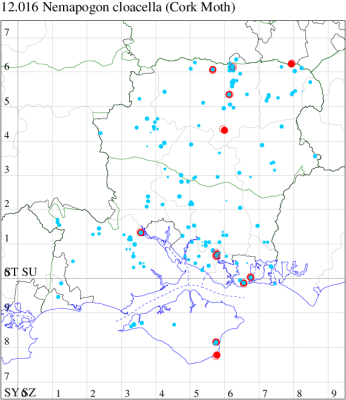
Records by year
Records by week (adult)
Records by week (larval)
Record Details
VC10: Bonchurch*, one, 02 Jun; one, 08 Jun; one, 24 Jun (JHa); Shanklin, one, gen det, 21 May; one, gen det, 26 May; one, field observation, 01 Jun; two, not dissected, 02 Jun; two, not dissected, 24 Jun; one, 01 Jul (IOu);
VC11: Totton, one, 21 May; one, 24 May (LH); Fareham, one, to actinic, 02 Jun; one, to actinic, 17 Jul (MLO); one, ♀, gen det, 10 Jun (KJW det. RJD); Portsmouth, one, 18 Jul (IRT); Sway*, one, 24 Jun (SKe); Southsea, one, 21 May; one, 25 May; one, 29 May; one, 31 May; one, 01 Jun (JRL);
VC12: Preston Candover, one, 12 Jul (MJW); Axmansford, one, 23 Jul (ACB det. GJD); Basingstoke, one, 26 Jun (MJW); Pamber Forest, one, 25 May; one, 23 Jun (GJD); Finchampstead, two, field observation, 07 Jul (JHH)
12.017 [B&F: 0217] Nemapogon koenigi Capu?e, 1967 - Nationally Scarce B
Previously known as Nemapogon wolffiella, synonymised in Ent Rec 128:2.
Nationally scarce (Nb) in woodland in southern England, with records north to Cumbria. In Hampshire very rare in the south-east of the county. Not recorded from the Isle of Wight to date. Wingspan 10-14 mm. Similar to other species of this group especially Cork Moth N. cloacella, but the ground colour is so dark that the markings corresponding to those of the other species are scarcely visible. Larva feeds on fungi and dead wood, often on Birch.
Records prior to 2020
| Vice County | #Records | #Individuals | First Record | Last Record |
|---|---|---|---|---|
| 11 | 12 | 8 | 1997 | 2015 |
2020 records
| Vice County | #Records | #Individuals | Max Quantity |
|---|---|---|---|
| 11 | 1 | 1 | 1 |
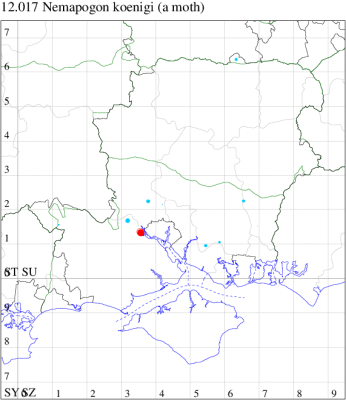
Records by year
Records by week (adult)
Records by week (larval)
Record Details
VC11: Totton, one, 09 Aug (LH)
12.019 [B&F: 0219] Nemapogon ruricolella (Stainton, 1849) - Nationally Scarce B
Nationally scarce (Nb) in woodland, heathland and commons throughout southern England. In Hampshire continues to be recorded at low densities in most years, but until rediscovered in Parkhurst Forest in 2020, there was only a single vague record from Wight, dated 1934, referenced in Goater, 1974. Wingspan 10-14 mm. Resembles the much more common Cork Moth N. cloacella most closely, but is usually recognisable by the pale reddish brown subapical area, less mottled than in Cork Moth, in which the whitish postmedian spot stands out distinctly, this spot being not as clearly rounded as in Cork Moth (MBGBI Vol 2). Larva feeds on various bracket fungi, including Razorstrop Fungus, a widespread resident on birch trees.
Records prior to 2020
| Vice County | #Records | #Individuals | First Record | Last Record |
|---|---|---|---|---|
| 10 | 1 | 0 | 1934 | 1934 |
| 11 | 31 | 37 | 1973 | 2019 |
| 12 | 12 | 12 | 1995 | 2019 |
2020 records
| Vice County | #Records | #Individuals | Max Quantity |
|---|---|---|---|
| 10 | 1 | 1 | 1 |
| 12 | 1 | 4 | 4 |
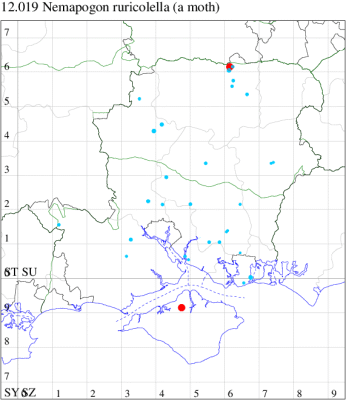
Records by year
Records by week (adult)
Records by week (larval)
Record Details
VC10: Parkhurst Forest*, one, 28 Jul (IOu);
VC12: Pamber Forest, four, 25 Jun (GJD)
12.021 [B&F: 0220] Nemapogon clematella (Fabricius, 1781) - Local
Local in woodland throughout most of England and Wales. In Hampshire widespread but apparently uncommon, although probably overlooked; very rare on the Isle of Wight and the imago was recorded for the first time in Shanklin, 2015. Wingspan 12-15 mm. Fairly unmistakable in appearance. Larva feeds on fungi and dead wood of Alder, Elm, Oak, Beech and Hawthorn.
Records prior to 2020
| Vice County | #Records | #Individuals | First Record | Last Record |
|---|---|---|---|---|
| 10 | 11 | 9 | 2006 | 2019 |
| 11 | 53 | 29 | 1981 | 2018 |
| 12 | 40 | 36 | 1980 | 2019 |
2020 records
| Vice County | #Records | #Individuals | Max Quantity |
|---|---|---|---|
| 10 | 2 | 2 | 1 |
| 12 | 2 | 2 | 1 |
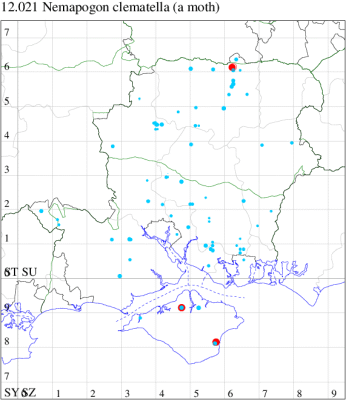
Records by year
Records by week (adult)
Records by week (larval)
Record Details
VC10: Parkhurst Forest, one, 29 Jun; Shanklin, one, 14 Aug (IOu);
VC12: Cholderton*, one, 08 Aug (TJN, HE); Pamber Forest, one, 10 Aug (GJD)
12.023 [B&F: 0226] Triaxomasia caprimulgella (Stainton, 1851) - pRDB1
An elusive species, said to favour dark shady places such as hollow trees and outbuildings. With the recent introduction of the LUN pheromone lure (primarily used to attract the Lunar Hornet Clearwing), sightings have dramatically increased in recent years, with a number from Middlesex, Surrey, and first recorded in Hampshire in July 2021; however the first record from our area was one retrospectively identified on the Isle of Wight from a photo in 2020. Most are caught at pheromone lure but does turn up at UV light. Wingspan 9-11 mm. The larva is thought to be a detritus feeding species, like most tineids.
Records prior to 2020
| Vice County | #Records | #Individuals | First Record | Last Record |
|---|
2020 records
| Vice County | #Records | #Individuals | Max Quantity |
|---|---|---|---|
| 10 | 1 | 1 | 1 |
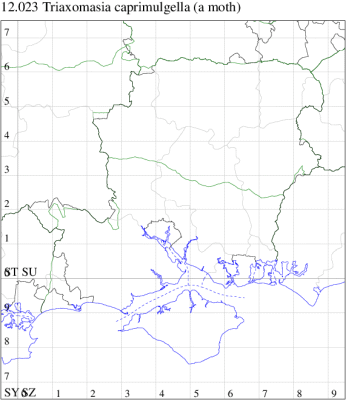
Records by year
Records by week (adult)
Records by week (larval)
Record Details
VC10: New Vice-county Record: Bonchurch*, one, 25 Jun (JHa det. MJW)
()(originally identified as Lampronia).jpg)